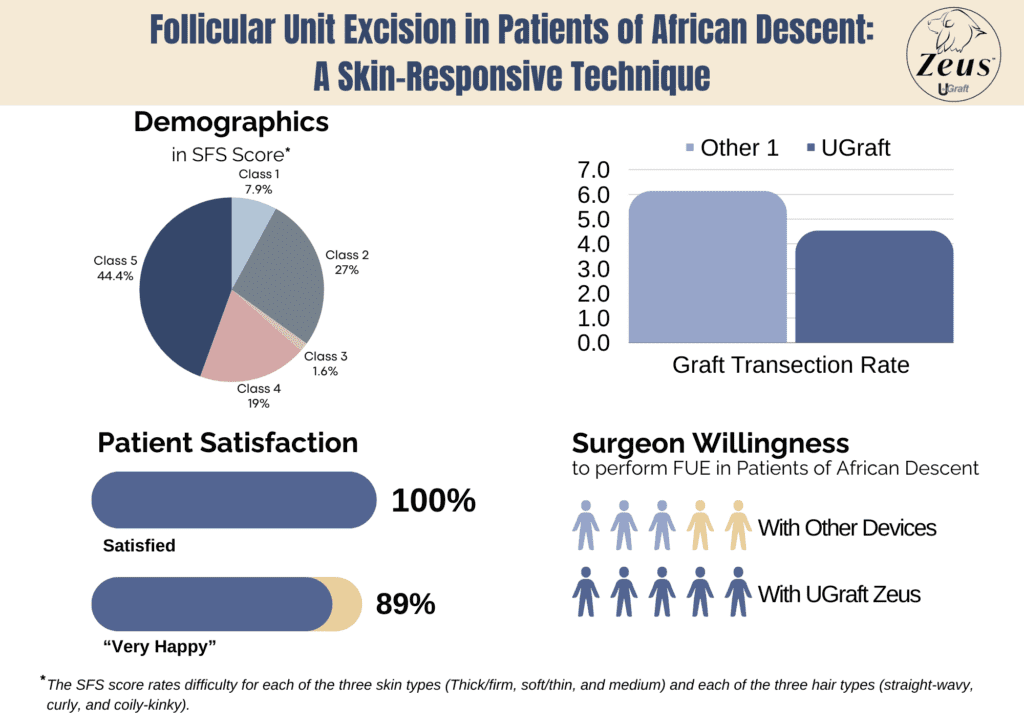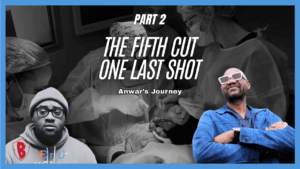Hair loss, specifically male-pattern baldness, has long been a concern for men seeking solutions to preserve their youthful appearance. Among the various techniques available, Follicular Unit Excision (FUE) has garnered significant attention due to its minimally invasive nature and the absence of linear scarring typical of other methods. However, there’s a distinct challenge when it comes to men of African descent who have a preference for closely shaved heads or shorter haircuts – the unique challenges posed by their hair and skin characteristics.

In a groundbreaking study conducted across multiple international clinics, a new skin-responsive FUE technique has emerged as a beacon of hope for African-descended individuals grappling with hair loss. The study, titled “Follicular Unit Excision in Patients of African Descent: A Skin-Responsive Technique,” was published in the Dermatologic Surgery journal. As the lead author of this study, I’m excited to delve into the details of our findings and share the implications for those who have long faced limitations in hair transplantation options.
The Predicament of African-Descended Individuals

African-descended individuals often face a conundrum when it comes to hair transplantation. Their hair’s coiled and kinky nature makes them particularly susceptible to scars caused by conventional FUE techniques that utilize larger punches. Moreover, many of these individuals have a preference for closely shaved hairstyles. This means that linear scars are not a viable option. Thus, they are often denied FUE hair transplants based on the challenges presented by their unique hair texture.
A Novel Approach: Skin-Responsive FUE Technique
Our study aimed to address these challenges head-on. We introduced a skin-responsive FUE technique designed to cater specifically to the hair and skin characteristics of African-descended patients. This technique involved analyzing FUE data from multiple clinics across different countries, with a focus on patients of African descent.

To create a comprehensive view, we employed the Sanusi FUE Scoring (SFS) scale. The scale combines skin and hair characteristics to assess the expected difficulty level of the FUE procedure. This scale, ranging from I to V, allowed us to predict the procedure’s success and graft attrition rate based on factors like skin thickness, hair curliness, etc.
The Impact of Skin and Hair Characteristics
Our study revealed that skin and hair characteristics play a pivotal role in determining the success of FUE procedures. We found that patients with thicker and firmer skin and those with coiled and kinky hair were more likely to experience higher graft attrition rates. This underscores the importance of developing techniques that adapt to these unique attributes.

Intriguingly, we also found that torque, the rotational force of the punch, was a crucial setting that affected the procedure’s success. We achieved consistently positive outcomes by optimizing torque settings based on skin thickness and firmness. Additionally, we observed that lower torque forces and shorter movement durations were better suited for women. This is because women generally have softer and thinner skin.

Key Findings

1. Patient Demographics
64 patients participated in the study, and 28 of those patients had Class V SFS score (highest FUE difficulty).
2. Graft Transection Rates with Skin-responsive UGraft FUE for Patients of African-Decent
Graft damage rates for all patients ranged between 3%-6%, with a total mean rate of 4.54%. This is a clear improvement from the previously recorded mean damage rate of 6.14% (Harris).
3. Patient Satisfaction with UGraft FUE
All patients in the study were highly satisfied, and 89% reported themselves as “very happy” with their FUE hair transplant results.
4. Surgeon Willingness to perform FUE on Patients of African Descent
Participating surgeons reported a notable rise in their readiness to carry out follicular unit extraction (FUE) procedures on patients of African descent. On a scale of 1-5, their willingness to perform the procedure went from a mean of 2.58 to 4.83 after using the UGraft Zeus.
Shifting the Paradigm
Our study presents a significant breakthrough for African-descended individuals seeking effective hair transplantation solutions. By tailoring the FUE technique to their unique hair and skin characteristics, we have unlocked the potential for better outcomes and reduced graft attrition rates.

This research doesn’t just provide hope for those with Afro-textured hair. It also sheds light on the need to develop techniques that cater to diverse populations’ specific requirements. As hair loss affects people of all ethnic backgrounds, a one-size-fits-all approach simply won’t suffice. Our study serves as a stepping stone toward addressing racial disparities in dermatologic care and offers a blueprint for more inclusive and practical solutions.
Our study’s findings hold tremendous promise for African-descended individuals facing hair loss challenges. Introducing a skin-responsive FUE technique addresses long-standing limitations and offers a path toward successful hair transplantation. As the lead author of this study, I’m thrilled to contribute to advancing medical practices that cater to diverse populations, ensuring that everyone can benefit from the latest innovations in the field.
References
- Umar S;Khanna R;Lohlun B;Maldonado JC;Zollinger M;Osei-Tutu A;Gonzales A;Chouhan K;Nusbaum A; (no date) Follicular unit excision in patients of African descent: A skin-responsive technique, Dermatologic surgery : official publication for American Society for Dermatologic Surgery [et al.]. Available at: https://pubmed.ncbi.nlm.nih.gov/37530735/#:~:text=Conclusion%3A%20The%20authors%20report%20consistence,influencers%20of%20graft%20attrition%20rate. (Accessed: 23 February 2024).
- Umar, S. et al. (2022) A new follicular unit excision donor scoring scale: CCID, Clinical, Cosmetic and Investigational Dermatology. Available at: https://www.dovepress.com/a-new-universal-follicular-unit-excision-classification-system-for-hai-peer-reviewed-fulltext-article-CCID (Accessed: 23 February 2024).




